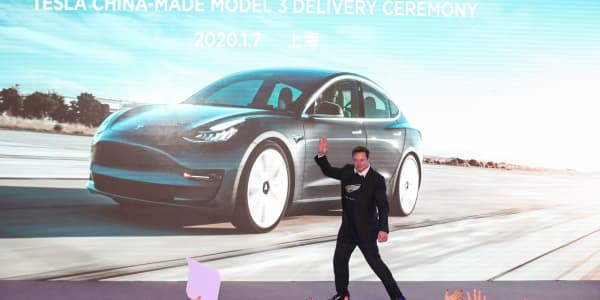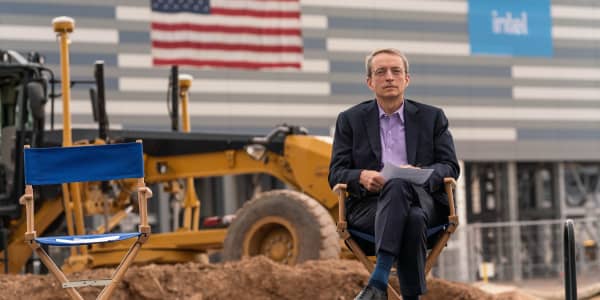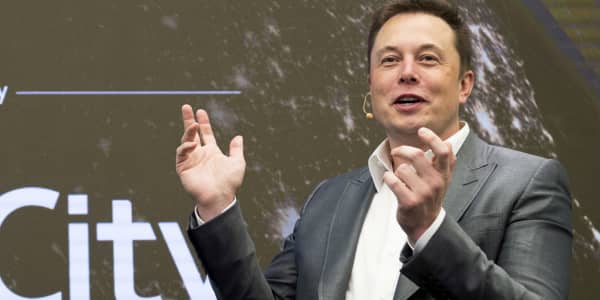Earlier this month, Toyota announced a research project that could help make hydrogen an energy game changer. In partnership with the Dutch Institute for Fundamental Energy Research, Toyota Motor Europe is developing a device that uses sunlight to produce hydrogen from humid air. If improved and scaled up, the solid-state photoelectrochemical cell might eventually power homes or cars.
It's one of the many promising technologies surrounding hydrogen, an energy source proponents say could help reduce our dependence on polluting fossil fuels. While dirty energy has been used to make hydrogen, the Toyota project, which has a grant from the Netherlands Organization for Scientific Research, would only use sunlight and air.
The research project reflects the Japanese conglomerate's renewed push into hydrogen. At last month's Consumer Electronics Show in Las Vegas, Toyota and truck maker Paccar showed off a hydrogen-powered fuel cell truck, the first of a series of prototypes that could help cut pollution at container terminals. But these initiatives are part of a larger effort to realize the clean-energy dreams of Japan itself.
It's easy to see why. Japan is the world's largest importer of liquefied natural gas (LNG) and among the top four coal and oil importers. It used to generate about 30 percent of its power from nuclear reactors before the Fukushima disaster in 2011 when a magnitude-9 earthquake and tsunami caused meltdowns, forcing the country to temporarily put all reactors offline. That accelerated Japan's push toward sustainable energy. Its goal: to build a hydrogen-based society and show off progress in 2020, when Tokyo hosts the Summer Olympics.
Just as the 1964 Tokyo Olympics left a legacy of widely used bullet trains, the 2020 Games would bequeath hydrogen infrastructure for future generations, former Gov. Yōichi Masuzoe declared. On a national level, the ambitious Strategic Energy Plan — that includes a 30-year road map on measures for manufacturing, transportation and storage — may serve as a model for other countries.
Major hurdles to overcome
But the shift has been challenging since it kicked off in 2014. Hydrogen must be produced, it can be difficult to transport and store, and fuel cells remain expensive and relatively inefficient. In 2016, Japan's Ministry of Economy, Trade and Industry (METI), decided that by 2020 there would be some 40,000 hydrogen fuel-cell vehicles (FCVs) on Japan's roads, along with 160 fueling stations and 1.4 million residential fuel cells, known as Ene-Farms. METI is expected to spend at least 108 billion yen (US$975 million) on hydrogen projects over a two-year period ending March 2020.
Yet with less than a year and a half to go before the Olympics opening ceremony, a hydrogen society seems a distant dream. Evidence of hydrogen power in everyday use is scant: Tokyo is supposed to have a fleet of more than 100 Toyota hydrogen fuel cell public buses operating by the Games, but only about seven are in service, shuttling between Tokyo Station and Tokyo Big Sight, a venue for meetings and tradeshows; a fueling station issue had halted the entire fleet in mid-February.
While there could be about 120 fueling stations in Japan by next year, construction costs are about triple those of gasoline stands and demand remains limited, especially outside big cities. In southern Japan's Saga Prefecture, for instance, there are only about 16 fuel cell vehicles and the only hydrogen station, built in 2016, sees only one customer per day, according to the Saga Shimbun newspaper. Fewer than 3,000 FCVs have been sold in Japan so far, according to Next Generation Vehicle Promotion Center, a Tokyo think tank, and cumulative sales are likely to be far short of the 40,000 goal for 2020. As for residential cells, cumulative sales only crossed the 250,000 threshold in July 2018, according to BloombergNEF.
Private-sector push
The country will likely fail to meet its goals, but it isn't putting the brakes on hydrogen. If anything, it's ramping up thanks to the private sector.
- In March 2018 a group of 11 Japanese companies, including Toyota, Nissan and Honda, launched a venture called Japan H2 Mobility (JHyM) to build 80 hydrogen fueling stations by 2022. The company says it has nearly completed 12 stations.
- The following month, Kawasaki Heavy Industries and other companies announced a project to extract hydrogen from brown coal in Australia and liquefy and ship it to Japan in massive quantities in a bid to lower costs.
- Another group, including oil and gas company Chiyoda, is planning to kick-start what it calls the first-ever international hydrogen supply route by importing up to 210 tons of hydrogen, enough to fill 40,000 FCVs, from Brunei in a demonstration next year.
- Last year Tokyu Hotels opened what it describes as the world's first hotel powered in part by hydrogen derived from waste plastic. Nicknamed The Warehouse, Kawasaki King Skyfront Tokyu REI Hotel has a fuel cell generating CO2-free electricity and hot water used in guest rooms, according to Toshiba Energy Systems & Solutions, which has provided similar cells to swimming pools and convenience stores.
Japan is also trying to increase domestic hydrogen production. It stood at an estimated 200 tons in April 2018, and by improving production technology and establishing regular hydrogen imports, the government wants to increase it to 4,000 tons in 2020 and 300,000 tons in 2030, according to METI's Hydrogen Basic Strategy.
Some projects are under way to boost output. For example, a consortium including Toshiba Energy Systems & Solutions and the New Energy and Industrial Technology Development Organization (NEDO), a state-backed R&D center, began construction of a facility in Fukushima last year that will produce up to 900 tons of hydrogen annually using wind and solar energy sources as well as grid electrical power. The hydrogen will be used to power FCVs and factories in northern Japan and elsewhere. Tokyo Gov. Yuriko Koike said it will also be used to run the athletes' village during the 2020 Games. In 2018, NEDO said a project it launched with Kawasaki Heavy Industries and construction firm Obayashi achieved the world's first supply of heat and electricity in an urban area using hydrogen alone as fuel. The goal is long-term development of a new energy supply method for communities.
"Energy transition will take a long time, and even in 2030 only 800,000 FCVs will be installed," said Eiji Ohira, a director at NEDO. "We are working on hydrogen with a view toward 2050. There are many challenges such as cost reduction, improving technology for hydrogen production, storage, transport and utilization. Japan will take a leadership in this field based on our experience in promoting hydrogen. Also, we are going to collaborate with other countries to realize a hydrogen-based society."
Toyota leads the way
Of all corporate Japan's hydrogen cheerleaders, Toyota Motor stands out for its commitment to FCVs. The Prius maker has been researching fuel cell technology for more than 25 years, with its first concept FCV making its debut in a parade in Osaka in 1996. In recent years, Toyota has been boosting investment in hydrogen fuel cell vehicles, designing lower-cost, mass market passenger cars and SUVs and pushing the technology into buses and trucks to build economies of scale.
By 2050, Toyota aims to cut global average CO2 emissions from its new vehicles by at least 90 percent compared to 2010. In December 2014, Toyota launched the world's first production FCV with the Mirai, a futuristic-looking sedan that has a range of 500 kilometers per tank. But its expensive fuel cell stack means the Mirai carries a hefty price tag of some $60,000 before incentives, one of several factors that have limited sales.
Japan will take a leadership in this field based on our experience in promoting hydrogen. Also, we are going to collaborate with other countries to realize a hydrogen-based society.Eiji Ohiradirector, New Energy and Industrial Technology Development Organization
As of the end of 2018, more than 7,500 units had been sold in about 16 countries, according to the automaker. It's now trying to shift to mass production ahead of the next-generation Mirai. Aside from hydrogen-powered semis and buses, Toyota has been expanding use of fuel cell forklifts at its Motomachi car plant in Toyota City and deploying them at the Port of Los Angeles. In 2018, it announced moves to expand production of fuel cell stacks and hydrogen tanks ten-fold after 2020, as well as plans to work with Seven-Eleven Japan to deploy small fuel cell delivery trucks. It hopes to sell more than 30,000 FCVs annually, but it sees FCVs as only one part of a mix including other forms of electric vehicles.
"For us, it is not a matter of trying to achieve [long-term hydrogen use] — we believe we must achieve this," said Hisashi Nakai of Toyota's Corporate & Technology Group. "Reducing the amount of CO2 emissions is an important issue and must gradually shift to emitting less CO2 as part of our energy consumption. Hydrogen is easier to store and transport when compared to electricity, and because it is simple to convert from electricity, it can address the challenges usually attributed to the conversion, transmission and distribution of electricity. We think that the use and application of hydrogen as an energy source is what we should be doing, so we are making efforts to help spread the use of FCEVs."
What lies ahead
Some experts think Japan has to concentrate more on the fundamentals of its hydrogen dream. Japan holds about 60 percent of worldwide fuel cell patents and invested nearly $15 billion on renewables, hydrogen and fuel cells from 1974 to 2015, according to Noriko Behling, co-author of a 2015 article on hydrogen in Japan in the Elsevier Economic Analysis and Policy Journal. But fuel cells need to be cheaper, more durable and efficient to spark real change.
"There is a fundamental need for greater investment in R&D with respect to hydrogen and fuel cell technologies, yet Japan's government is cutting R&D," said Behling, pointing to decreasing government outlays.
Martin Tengler, an energy analyst at BloombergNEF in Tokyo, said many researchers are working on improved fuel cell designs and more efficient storage options, such as metal hydrides, but it's unknown whether these will reach commercialization. Cost and the participation of other countries will be the overriding factors in the viability Japan's hydrogen utopia.
"It's too early to tell how viable an energy source hydrogen could be for Japan," said Tengler. "Current estimates put the cost of importing hydrogen in 2025 at over twice the current price of imported LNG, but it's early days for the technology. If it follows the rapid cost reduction path that solar and wind technologies have, then costs could fall much faster than is currently expected."





